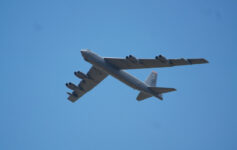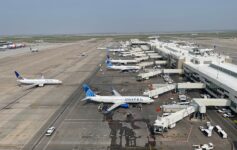
A Southwest Airlines 737 MAX 8 experienced a Dutch Roll at 32,000 feet, which is not a pastry from Holland but a scary technical incident that put the aircraft out of commission and has prompted a federal investigation.
Southwest Airlines Boeing 737 MAX 8 Encounters Dutch Roll At 32,000 Feet
Let’s review the incident, as flagged by The Aviation Herald:
- The incident occurred on Saturday, May 25, 2024 on WN746 from Phoenix (PHX) to Oakland (OAK)
- The aircraft involved was a Boeing 737 MAX 8 aircraft, registration N8825Q
- While traveling at 32,000 feet, about 40 mintues after takeoff, the aircraft encountered a Dutch Roll
- A Dutch Roll is when the “aircraft oscillates around its vertical as well as longitudinal axis” meaning the tail wags like a dog (the yaw) while simultaneously rocking from side to side (the roll)
- The incident was temporary and pilots continued to fly to Oakland, landing 55 minutes later
- Damage to the power control unit (PCU) was found upon landing
- For 12 days, the aircraft remained on the ground in Oakland
- On June 6, 2024, the aircraft was ferried to Boeing Paine Field (PAE) near Seattle for further inspection where a Southwest maintenance vendor is examining the aircraft
- The US Federal Aviation Administration is also investigating
Before this morning I had never heard of a Dutch Roll and had to look it up. This video was helpful:
Most pilots train for Dutch Rolls in flight simulators but never actually experience on in real-life. We should all be thankful that the Southwest pilots were able to regain control.
Rather than speculate about what this means for the future of Boeing or the 737 MAX 8 program, I will only say that this is serious and you’ll be hearing a lot more about this in the mainstream media over the next two days. I am hopeful this was a one-off incident and will not expose another structural flaw to the 737 MAX. Some believe the aircraft may have exceeded Mach 1 (the sound barrier) and that may have caused the incident, which would be a tidy explanation, but it is too early to say.
At this point, I would still not hesitate to fly on a 737 MAX or take my family on one…but I will also be watching this investigation closely.
CONCLUSION
A Southwest 737 MAX 8 encoutered a Dutch Roll enroute to Oksland, Calfiornia. No passengers were injured and pilots regained control of the jet, but the aircraft has now been out of service for three weeks and the FAA is investigating.
I am shocked we have not heard more about what passengers experienced onboard!
Were you a passenger on WN746? Let us know what happened onboard in the comments section below.
image: Bill Abbott // hat tip: BP




Glad I’m not the only one who never heard of a Dutch Roll before today.
I agree with not speculating on what this means for the Max 8 but it’s easy to say it’s not good.
And I also wonder why in today’s social media age we haven’t anything from passengers yet. Very strange.
I was wondering the same about the pax on the flight. But I would think most would be fairly unaware given the specifics of a Dutch roll married with the fact that most pax are not pilots or even remotely knowledgable on flight mechanics and aerodynamics. I would assume most thought it was just some sort of turbulence or part of a course correction or something of that nature. But having never experienced one myself, I’m curious to hear how it feels from inside the aircraft.
Yeah, I’d never heard of a “Dutch Roll” either. I just assumed it was a euphemism for something…..
You are making a huge assumption that this has something to do with the aircraft. But hey, let’s jump to conclusions. Most likely this was a weather-related incident combined with the speed of the aircraft.
On the contarry, I am making no assumptions here.
And on what basis are you making your assumption?
Surprised the readers including the author never heard of dutch roll. It’s a phenomenon well known in swept wing aircraft design. This is one thing that test pilots test for prior to certification of the aircraft.
Hope you feel better about yourself now!
I’m less alarmed by the Dutch roll and more alarmed that the pilots decided to fly 55 more minutes after a major controllability issue. Flight control issues are a MASSIVE reason to declare an emergency. Massive cannot be emphasized enough. That screams more to me pilot input error than mechanical issue. The PCU failure was a standby PCU that isn’t even active during normal flight and very well could’ve been damaged during the recovery or initial condition leading to the Dutch roll.
@Big … Might they have diverted to either LAS or FAT ?
Depending on where it occurred, it depends. Looks like the flight typically runs about 2 hours and based off some of the routings, the halfway point is right around LAX. There are plenty of suitable airports along the route. I’m not sure I would call OAK nearest suitable, especially since structural damage occurred to the airframe. (2 ribs in the tail)
Is it going to take the deaths of 175 AS or WN pax on a MAX for people to take all these issues seriously? Or are all these issues with the MAX just one big coincidence?
On a stable aircraft, Dutch roll is supposed to work itself out over time, but also makes me wonder if autopilots are smart enough to correct for Dutch roll if it does happen to an airliner, or would the pilots have to go to manual control if the autopilot can make it worse if it starts happening.
I’ve never experienced one personally, but depending on the duration of each cycle, the passengers probably never felt much more than a shift in inertia. Like taking a few turns in succession in your car.
Clickbait, Clickbait, Clickbait
Dutch Roll is a fairly common, controllable event that can be induced by turbulence, mountain waves, etc. Just pull the power back a bit, airplane settles down and life goes on.
For what it’s worth, this plane came no where near Mach 1 as “some believe.” Always a reliable source, those some believers.
We are glad you are so confident there was nothing going on.
Thanks Matt. Just a little insight from a professional, I said my piece.
I’ll let you guys continue to speculate and fear monger.
From one Boeing pilot to another, just keep on thinking 2 broken ribs in the vertical stab due to Dutch Roll is normal and fairly common. Maybe take the foggles off once in a while.
I’d like to hear Blancoliro Channel’s (YouTube) take on this.. I suspect he’ll be in alignment with Boeing Pilot. A brief anomaly in handling requires a systems check, as was done. It’s seems premature to call this a serious issue of a fleet wide nature.
If I understand this correctly, it’s a known in-flight phenomenon that pilots are trained for regardless of aircraft type. It remains to be seen if it was caused by a system on this aircraft. I am glad that we have transparency when these issues arise and that there are people (i.e. Blancolorio) who follow these incidents which helps maintain that transparency.
Probably caused by dei that southwest has been big on.
Ha! Way to troll the trolls!
It probably was also partly caused by the solar panels or wind turbines in the ground below the plane…. Installed by a dei hire!
Good to know we can always count on a racist to chime in. LOL. Unreal
I saw the headline and thought maybe someone had messed up the roof of their mouth on a Dutch Crunch Roll.
Roep de hele dag om help! Maar d’r is niemand die me helpt.
Reading that one possibility is the power control unit (PCU) may have been damaged before the flight causing the Dutch Roll, not damaged because of the Dutch Roll.
Was this the MCAS going haywire again?
(For the Massholes: that stands for Maneuvering Characteristics Augmentation System, not Massachusetts Comprehensive Assessment System.)
Too much automation…too much computerization of flight controls.
I want you all to think about life without pilots…..if it ever happens it will not be good for safety. Aviation new tech is just bad and not necessary.
Was it really Dutch Roll or did the pilots state it was? Why do I ask because most pilots have read about Dutch roll which occurred in heavily swept wing aircraft but rarely occurs on wings as those on the 737 bit have never actually experienced it. The wing in the Max same as the wing of the NG. Yes you can get yaw and then that is exacerbated by ride or rudder movement on loss of a PCU which might affect yaw damping. But until you actually see the data, which no news outlet has seen…only SWA and maybe the NTSB at this point you can’t call it anything other than a malfunction of the PCU. So please stop the scare stories because at the end of the day the aircraft continued to destination.